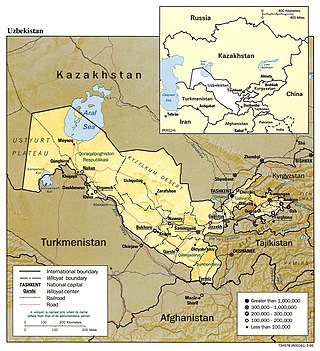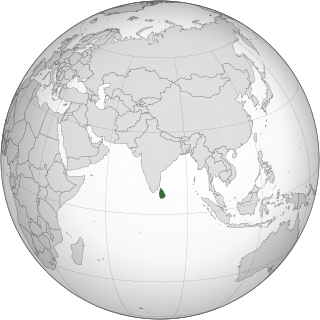
Environmental laws are laws that protect the environment. Environmental law is the collection of laws, regulations, agreements and common law that governs how humans interact with their environment. This includes environmental regulations; laws governing management of natural resources, such as forests, minerals, or fisheries; and related topics such as environmental impact assessments. Environmental law is seen as the body of laws concerned with the protection of living things from the harm that human activity may immediately or eventually cause to them or their species, either directly or to the media and the habits on which they depend.

Georgia is a country in the Caucasus region, on the coast of the Black Sea. Sometimes considered a transcontinental country, it is located at the intersection of Eastern Europe and West Asia, and is today generally regarded as part of Europe. It is bordered to the north and northeast by Russia, to the south by Turkey and Armenia, and to the southeast by Azerbaijan.
Kyrgyzstan is a landlocked nation in Central Asia, west of the People's Republic of China. Less than a ninth the size of Kazakhstan, at 199,951 square kilometers, Kyrgyzstan is one of the smaller Central Asian states. The national territory extends about 900 km (560 mi) from east to west and 410 km (250 mi) from north to south.

Uzbekistan is a country in Central Asia, located north of Turkmenistan and Afghanistan. With an area of 447,000 square kilometers, Uzbekistan stretches 1,425 km (885 mi) from west to east and 930 km (580 mi) from north to south. It borders Turkmenistan to the southwest, Kazakhstan to the north and Tajikistan and Kyrgyzstan to the south and east. Uzbekistan also has four small exclaves in Turkmenistan.

Environmental protection is the practice of protecting the natural environment by individuals, groups and governments. Its objectives are to conserve natural resources and the existing natural environment and, where it is possible, to repair damage and reverse trends.

Environmental degradation is the deterioration of the environment through depletion of resources such as quality of air, water and soil; the destruction of ecosystems; habitat destruction; the extinction of wildlife; and pollution. It is defined as any change or disturbance to the environment perceived to be deleterious or undesirable.

The Singapore Green Plan (SGP) was created in 1992 to ensure that the economic growth model of Singapore does not compromise the environment. The SGP sets out the strategies, programs and targets for Singapore to maintain a quality living environment while pursuing economic prosperity. The focus areas in the SGP are led by a main coordinating committee and respective action program committees. Since 1992, the SGP has been continuously updated to ensure its relevance, releasing SGP 2012 in 2002 and SGP 2030 in 2021. The United Nations (UN) Sustainable Development Goals (SDG) are correlated or mapped to the SGP.

Conservation Law Foundation (CLF) is an environmental advocacy organization based in New England. Since 1966, CLF's mission has been to advocate for New England's environment and its communities. CLF's advocacy work takes place across five integrated program areas: Clean Energy & Climate Change, Clean Air & Water, Healthy Oceans, People & Justice, and Healthy Communities. CLF uses the law, science, and the market to create solutions that preserve natural resources, build healthy communities, and sustain a vibrant economy. CLF works to promote renewable energy and fight air and water pollution; build sustainable fishing communities and protect marine habitat; promote public transit and defend public health; achieve environmental justice; and sustain a vibrant, equitable economy.
The major environmental issues in Kyrgyzstan, are summarized in the 2007 Concept of Ecological Security of Kyrgyz Republic and discussed in other environmental and environmental policy documents such as National Environmental Action Plan (1995), Country Development Strategy for 2009–2011, Strategy on Biological Diversity (2002), 2nd Environmental Performance Review of Kyrgyzstan (2008), etc.
Today, environmental problems in the Philippines include pollution, mining and logging, deforestation, threats to environmental activists, dynamite fishing, landslides, coastal erosion, biodiversity loss, extinction, global warming and climate change. Due to the paucity of extant documents, a complete history of land use in the archipelago remains unwritten. However, relevant data shows destructive land use increased significantly in the eighteenth century when Spanish colonialism enhanced its extraction of the archipelago's resources for the early modern global market. The Philippines is projected to be one of the most vulnerable countries to the impacts of climate change, which would exacerbate weather extremes. As the Philippines lies on the Pacific Ring of Fire, it is prone to natural disasters, like earthquakes, typhoons, and volcanic eruptions. In 2021, the Philippines ranked the fourth most affected country from "weather-related loss events", partly due to the close proximity of major infrastructure and residential areas to the coast and unreliable government support. One of the most devastating typhoons to hit the archipelago was Typhoon Haiyan, known locally as Yolanda, in 2013 that killed 6,300 people and left 28,689 injured. Congress passed the Clean Air Act of 1999, the Philippine Clean Water Act of 2004, the Climate Change Act of 2009 to address environmental issues. The country is also a signatory to the Paris Agreement. However, research has found that outside of cities, the general public doesn't feel equally informed. Environmental activists and land defenders, consisting mostly of Indigenous communities who have been attempting to bring attention to the environmental issues in the country have been met with violence or murder. As a result, the Philippines has been ranked one of the most dangerous places in the world for environmental activists.
Environmental issues in Pakistan include air pollution, water pollution, noise pollution, climate change, pesticide misuse, soil erosion, natural disasters, desertification and flooding. According to the 2020 edition of the environmental performance index (EPI) ranking released by Yale Center for Environmental Law & Policy, Pakistan ranks 142 with an EPI score of 33.1, an increase of 6.1 over a 10-year period. It ranked 180 in terms of air quality. The climatic changes and global warming are the most alarming issues risking millions of lives across the country. The major reasons of these environmental issues are carbon emissions, population explosion, and deforestation.

Environmental issues in Nepal include a number of issues, such as deforestation, climate change, energy and species conservation. Many of these issues have been precipitated by rapid industrialization without major environmental regulation.

Environmental issues in the United States include climate change, energy, species conservation, invasive species, deforestation, mining, nuclear accidents, pesticides, pollution, waste and over-population. Despite taking hundreds of measures, the rate of environmental issues is increasing rapidly instead of reducing. The United States is among the most significant emitters of greenhouse gasses in the world. In terms of both total and per capita emissions, it is among the largest contributors. The climate policy of the United States has a major influence on the world.
Environmental issues in Brazil include deforestation, illegal wildlife trade, illegal poaching, air, land degradation, and water pollution caused by mining activities, wetland degradation, pesticide use and severe oil spills, among others. As the home to approximately 13% of all known species, Brazil has one of the most diverse collections of flora and fauna on the planet. Impacts from agriculture and industrialization in the country threaten this biodiversity.

There are multiple environmental issues in India. Air pollution, water pollution, garbage, domestically prohibited goods and pollution of the natural environment are all challenges for India. Nature is also causing some drastic effects on India. The situation was worse between 1947 through 1995. According to data collected and environmental assessments studied by World Bank experts, between 1995 through 2010, India has made some of the fastest progress in addressing its environmental issues and improving its environmental quality in the world. However, Pollution still remains a major challenge and opportunity for the country.

Environmental issues are disruptions in the usual function of ecosystems. Further, these issues can be caused by humans or they can be natural. These issues are considered serious when the ecosystem cannot recover in the present situation, and catastrophic if the ecosystem is projected to certainly collapse.
Waste management in Kazakhstan is an important concern within the country, considering the billions of tons of industrial waste produced yearly, the currently less-than-optimal state of solid waste management, and existing toxins remaining from both pollutants and Kazakhstan's historical position as the USSR's testing grounds for rockets and nuclear weapons. Kazakhstan has very few services for recycling solid waste, and waste management is currently dealt with using regional programs.

Environmental issues in Sri Lanka include large-scale logging of forests and degradation of mangroves, coral reefs and soil. Air pollution and water pollution are challenges for Sri Lanka since both cause negative health impacts. Overfishing and insufficient waste management, especially in rural areas, leads to environmental pollution. Sri Lanka is also vulnerable to climate change impacts such as extreme weather events and sea level rise.

The State of Israel is one of the smallest countries in the world, around 20,000 sq. km, and has relatively few natural resources. Due to its limited space, semi-arid climate, high population growth and resource scarcity, Israel is highly susceptible to environmental crises. These include water shortages and pollution, shrinking of the Dead Sea, waste production and disposal, air pollution and population density. As a result, resource development, in particular water, has benefited from relatively high government support throughout most of the country's history. For example, Israel's water conservation and reclamation infrastructure is one of the most advanced in the world, with approximately half its water supply derived from reclaimed and treated waste water, brackish water and desalinated water.

The environment of Bosnia and Herzegovina consists of diverse climates, flora and fauna, natural landmarks and landscapes. The climate ranges from continental, oceanic, subtropical and Mediterranean throughout different regions of the country. Most of the Dinaric Alps are located in Bosnia and Herzegovina, the highest elevation point is the mountain Maglic at 2,386 (7,828 ft), while the lowest point of elevation is the Adriatic Sea in the South of the country. 42.8% of the land is covered in thick forests. The country is rich in water resources, and in certain places, rivers and springs may be used without previous filtration. Significant rivers are the Drina, Neretva, Sava, Bosna and Una. Important national parks include Kozara National Park, Sutjeska National Park, and Una National Park, all nationally protected areas.

















